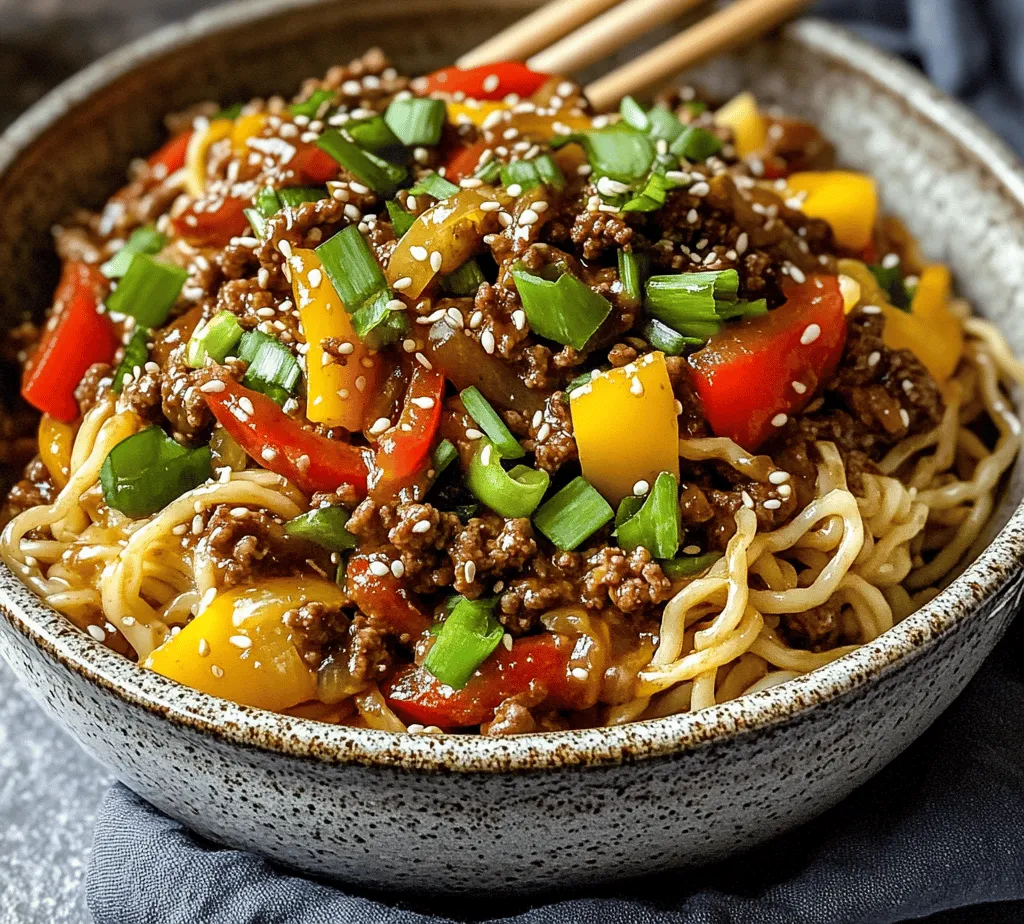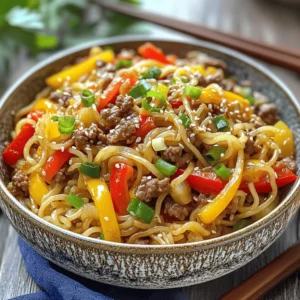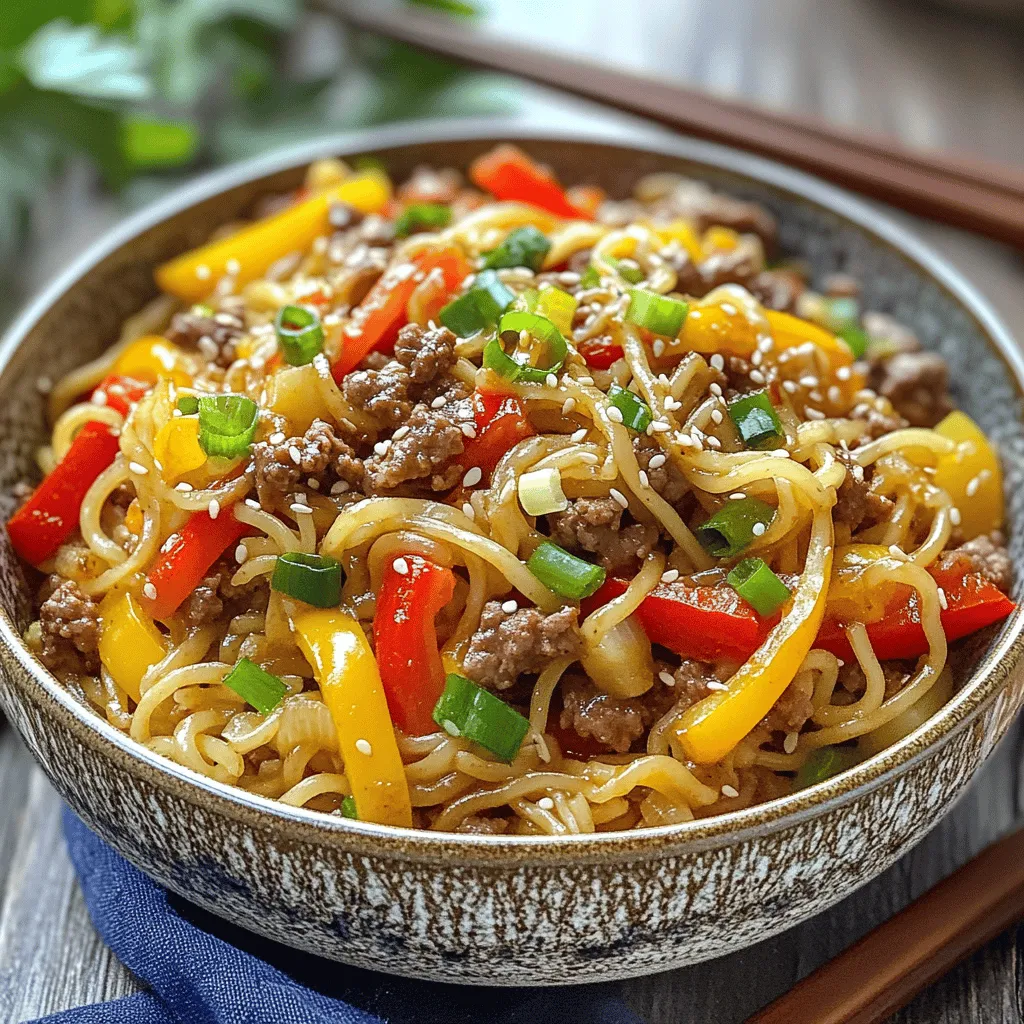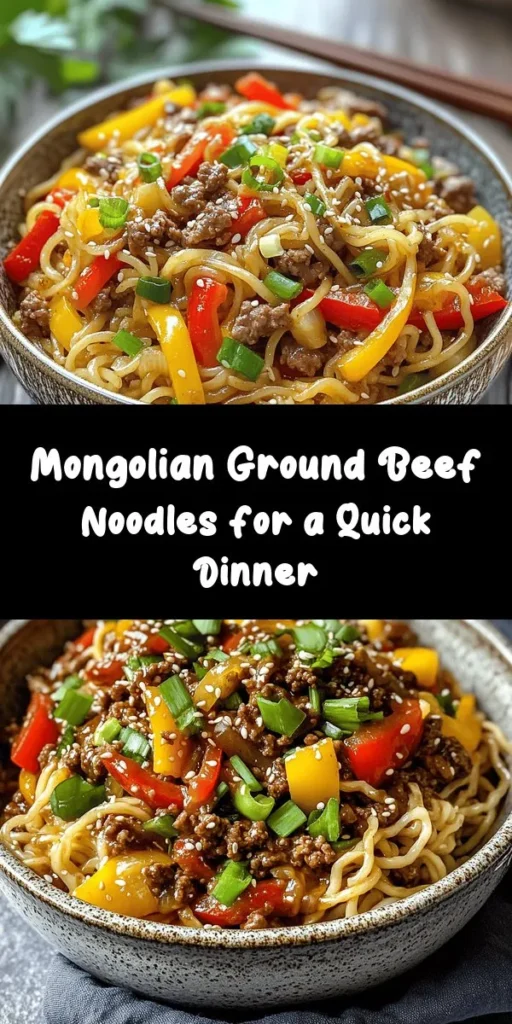Introduction
Mongolian cuisine, often characterized by its hearty flavors and wholesome ingredients, draws influences from various cultures, including Chinese and Tibetan. Though it may not be as widely recognized as some other Asian cuisines, Mongolian dishes are known for their bold flavors and satisfying textures. The cuisine typically features a range of meats, especially lamb and beef, paired with fresh vegetables and simple, yet delightful seasonings. One standout dish that encapsulates these qualities is the Mongolian Ground Beef Noodles, a quick and delectable option for dinner that packs a punch of flavor while being easy to prepare.
This recipe is perfect for those hectic weeknights when you need to whip up something delicious in no time. The combination of ground beef, savory sauces, and crisp vegetables served over tender noodles creates a perfect harmony of protein, carbs, and nutrients, making it an ideal meal for families and busy individuals alike. Not only is this dish satisfying, but it also brings a vibrant array of colors and textures to your table, elevating a simple dinner into a delightful experience.
In this article, we’ll break down the essential ingredients for Mongolian Ground Beef Noodles, delve into their roles in the recipe, and guide you through the preparation steps to ensure your dish turns out perfectly every time.
Understanding the Ingredients
Ground Beef: The Heart of the Dish
At the core of this recipe is ground beef, which serves as both the primary protein source and the flavor foundation for the dish. Ground beef is not only versatile but also absorbs the rich flavors of the accompanying sauces, enhancing the overall taste of the noodles. When selecting ground beef, aim for a blend with a moderate fat content, such as 80/20, which will provide a juicy and flavorful base while cooking. The fat renders down, adding richness to the dish, while the protein ensures that you feel full and satisfied.
Noodles: The Perfect Base
When it comes to noodles, egg noodles are the traditional choice for this recipe. Their slightly chewy texture and ability to hold onto sauces make them an ideal companion for the flavors of Mongolian beef. If you can’t find egg noodles or prefer a different option, feel free to substitute them with rice noodles or even whole wheat pasta for a healthier alternative. The key is to choose noodles that can absorb the sauce while maintaining a pleasant bite.
Aromatics: Garlic and Ginger
Garlic and ginger are essential aromatics that form the backbone of many Asian dishes, including this one. Both ingredients not only add depth and complexity to the flavor profile but also contribute to the overall aroma of the dish. Garlic delivers a pungent, savory note, while ginger adds a warm, slightly spicy undertone. When incorporated at the right moment during cooking, these aromatics can elevate the dish significantly, creating a fragrant and mouthwatering base for the beef and noodles.
Sauces: The Umami Trio
The trio of sauces—soy sauce, hoisin sauce, and oyster sauce—plays a crucial role in achieving the characteristic umami flavor that is so beloved in Mongolian dishes.
– Soy Sauce: This fundamental ingredient provides saltiness and depth, enhancing the savory notes of the beef. It’s essential to use a good quality soy sauce, as it forms the base of the sauce mixture.
– Hoisin Sauce: Known for its sweet and tangy flavor, hoisin sauce adds a rich complexity to the dish. It brings a slight sweetness that balances the saltiness of the soy sauce, making it essential for achieving a well-rounded flavor.
– Oyster Sauce: This sauce adds a unique depth of flavor, often described as slightly sweet and savory. It enhances the richness of the dish and ties all the flavors together harmoniously.
Vegetables: Color and Nutrition
In addition to the beef and noodles, incorporating vegetables such as bell peppers and carrots not only adds color but also contributes vital nutrients to the dish. Bell peppers provide a sweet crunch, while carrots offer a hint of natural sweetness and a splash of vibrant orange. These vegetables complement the beef beautifully and add texture, making every bite more enjoyable. Feel free to experiment with other vegetables like snap peas or bok choy for added variety.
Garnishes: The Finishing Touch
To elevate your Mongolian Ground Beef Noodles further, consider garnishing the dish with sliced green onions and sesame seeds. Green onions bring a fresh, crisp bite that contrasts nicely with the rich noodles and beef, while sesame seeds add a delightful nuttiness and visual appeal. These simple garnishes not only enhance the presentation but also contribute additional layers of flavor that make the dish even more enticing.
Preparation Steps Explained
Cooking the Noodles: The Importance of Al Dente Texture
The first step in preparing your Mongolian Ground Beef Noodles is cooking the noodles. It’s essential to follow the package instructions carefully, ensuring that the noodles are cooked to an al dente texture. Al dente refers to a firmness that allows the noodles to have a slight bite, preventing them from becoming mushy when combined with the stir-fried beef and sauce. After cooking, drain the noodles and rinse them under cold water to stop the cooking process and prevent sticking.
Browning the Beef: Technique for Flavor and Texture
Browning the ground beef is one of the most critical steps in the cooking process. To achieve the best flavor and texture, use a large skillet or wok over medium-high heat. Once hot, add the ground beef, breaking it up with a spatula as it cooks. Allow the beef to sear without stirring for a couple of minutes, which helps develop a rich, caramelized crust. This step is essential for enhancing the beef’s natural flavors and creating a depth that will permeate the entire dish. Cook the beef until it is fully browned and no longer pink, then drain any excess fat if necessary.
Aromatics and Timing: The Significance of Early Addition
Once the beef is browned, it’s time to add the aromatics. Introduce the minced garlic and ginger to the skillet, stirring them into the beef. The timing of this step is crucial; adding the garlic and ginger after the beef has browned allows their flavors to infuse into the meat, creating a fragrant base for the dish. Sauté the mixture for about 30 seconds until the garlic is golden and aromatic, being careful not to let it burn, as burnt garlic can impart a bitter taste.
Creating the Sauce: Balancing Flavors
With the beef and aromatics cooked to perfection, it’s time to create the sauce that will bring everything together. In a small bowl, combine the soy sauce, hoisin sauce, and oyster sauce, mixing them until well blended. Pour this sauce mixture over the beef and aromatics in the skillet, stirring to coat the ingredients evenly. As the sauce heats, it will thicken slightly, enveloping the beef and noodles in a savory glaze. Taste the sauce and adjust the flavors as necessary, adding a bit more soy sauce for saltiness or hoisin for sweetness, ensuring a well-balanced flavor profile that suits your palate.
This careful attention to the cooking process and ingredient selection will ensure that your Mongolian Ground Beef Noodles are not only quick to prepare but also bursting with flavor, making it a standout dish for any dinner table. In the next section, we will cover additional tips for achieving the best results and address common questions about preparing this delicious meal.

Stir-Frying Vegetables: Techniques for Retaining Crunch and Color
Stir-frying is a quick and efficient cooking method that allows you to achieve vibrant, crunchy vegetables that not only enhance the dish’s texture but also its visual appeal. When preparing your Mongolian Ground Beef Noodles, it’s crucial to follow several techniques to ensure your vegetables remain crisp and colorful.
1. Prep Ahead: Before you start cooking, wash, peel, and chop all your vegetables. This ensures that once you begin stir-frying, everything is ready to go, allowing you to maintain high heat without overcooking.
2. High Heat: Use a wok or a large skillet over high heat. This method ensures that vegetables cook quickly while retaining their natural juices and crunch.
3. Oil Choice: Use oils with a high smoke point, such as vegetable oil or peanut oil. These oils can withstand high temperatures without breaking down, which is essential for achieving that perfect stir-fried finish.
4. Batch Cooking: If you’re using a variety of vegetables, consider stir-frying them in batches. Start with the firmer vegetables (like carrots and bell peppers) and add the softer ones (like broccoli and snow peas) later. This stratification allows each vegetable to cook to its ideal texture.
5. Quick Tossing: After adding the vegetables to the pan, toss them frequently. This technique allows for even cooking and prevents any burning, ensuring that each piece stays vibrant and crunchy.
Combining Ingredients: Tips for Evenly Coating Noodles and Vegetables with Sauce
Once your vegetables are perfectly stir-fried, it’s time to combine them with the noodles and the savory sauce. Achieving an even coating is essential for a well-balanced flavor throughout the dish.
1. Sauce Preparation: Before combining, make sure your sauce is ready. A well-mixed sauce will ensure every bite is flavorful. Typically, a combination of soy sauce, garlic, ginger, and a pinch of sugar works wonders.
2. Tossing Method: When adding the noodles to the stir-fried vegetables, use a gentle tossing method rather than stirring vigorously. This technique helps prevent the noodles from breaking while ensuring that the sauce coats every ingredient evenly.
3. Heat Control: Keep the heat at medium-high while combining. This will help the sauce thicken slightly as it clings to the noodles and vegetables, enhancing the overall flavor.
4. Add in Stages: If you’re using a thicker sauce, consider adding it in stages. Start with a small amount, tossing to coat, and then add more if needed. This prevents overwhelming the noodles and allows you to control the flavor intensity.
Nutritional Information
To ensure you’re making a wholesome choice with your Mongolian Ground Beef Noodles, here’s a breakdown of the nutritional values per serving:
– Calories: Approximately 450-500 calories
– Protein: 30-35 grams (from ground beef and vegetables)
– Carbohydrates: 50-60 grams (from noodles and vegetables)
– Fiber: 4-6 grams (from the variety of vegetables used)
– Vitamins: Rich in Vitamin A (from carrots and bell peppers) and Vitamin C (from broccoli and snow peas)
Dietary Adjustments
This recipe is versatile and can be tailored to meet dietary needs. For those seeking a gluten-free option, substitute traditional noodles with gluten-free alternatives such as rice noodles or zucchini noodles. Additionally, consider leaner protein options like ground turkey or plant-based proteins to cater to various dietary preferences.
Cooking Tips for Success
While preparing Mongolian Ground Beef Noodles is straightforward, here are some common pitfalls to avoid for a perfect dish:
– Avoid Overcooking: Stir-frying is meant to be fast. Keep an eye on your vegetables and meat to avoid overcooking, which can lead to a rubbery texture.
– Fresh Ingredients: Always use fresh vegetables and high-quality meat. Fresh produce not only enhances flavor but also contributes to a more vibrant dish.
– Customize Your Dish: Feel free to customize the recipe with your choice of vegetables or proteins. Bell peppers, bok choy, and baby corn work well, while tofu or chicken can serve as excellent protein substitutes.
Serving Suggestions
To elevate your dining experience, consider these complementing side dishes and drinks that pair beautifully with your Mongolian Ground Beef Noodles:
1. Side Dishes:
– Asian Cucumber Salad: A fresh and crunchy salad adds a refreshing contrast to the hearty noodles.
– Spring Rolls: Light and crispy, these are perfect for a starter or side dish.
– Steamed Dumplings: A great accompaniment that enhances the Asian theme.
2. Beverage Pairings:
– Green Tea: A classic choice that complements the flavors without overpowering them.
– Asian Beer: Consider pairing with a light lager or a wheat beer for a refreshing taste.
– Sparkling Water with Lime: A non-alcoholic option that cleanses the palate.
3. Presentation Tips:
– Serve the noodles in a large, shallow bowl and garnish with sliced green onions or sesame seeds for a pop of color.
– Consider using chopsticks for an authentic experience, which also adds to the aesthetic appeal of the dish.
Conclusion
The Mongolian Ground Beef Noodles recipe is a delightful and simple dish that brings a burst of flavor and texture to your dining table. It’s perfect for a quick weeknight dinner or a family favorite that everyone will love. With a few fresh ingredients and straightforward techniques, you can create a meal that’s both satisfying and nutritious.
This recipe’s versatility allows for endless variations, so don’t hesitate to experiment with different vegetables and proteins based on your preferences. Whether you enjoy it as is or customize it to suit your taste, this dish is sure to become a staple in your recipe repertoire. Embrace the simplicity and deliciousness of Mongolian Ground Beef Noodles, and enjoy sharing it with family and friends!



